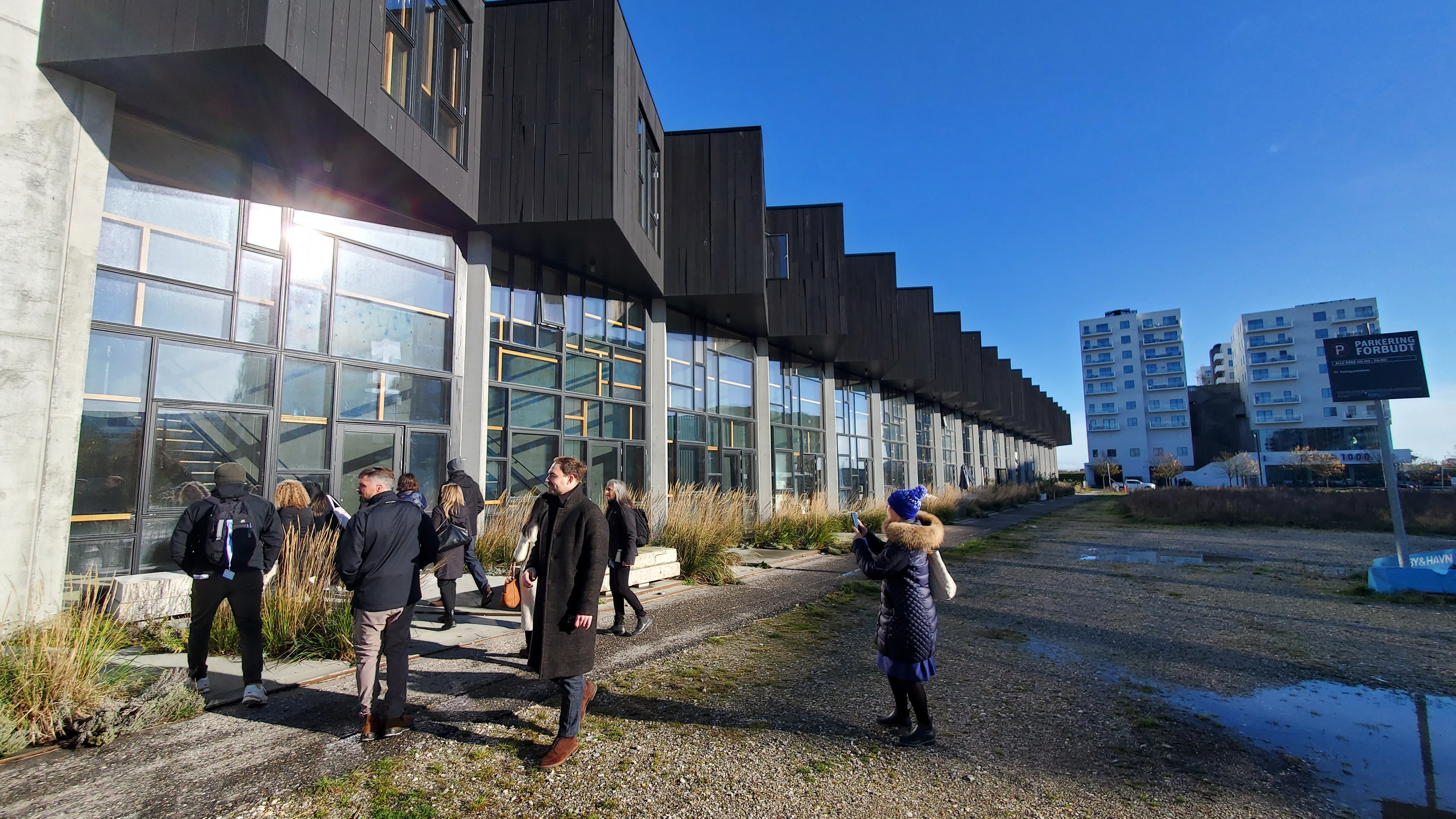Lessons from Denmark on Sustainable Design and Whole Life Carbon Emissions

By Jeremy Field
Copenhagen is the UNESCO World Capital of Architecture for 2023. As part of the celebrations, I was Introba’s representative in an international group of built-environment thought leaders invited by State of Green and Creative Denmark to explore the energy-efficient buildings of Denmark’s capital and to gain insights from the local design community.
It was fantastic to see tangible proof of how sustainable design can have far-reaching positive impacts, such as making the Danish capital city (and third most sustainable city in the world) so much quieter. Denmark is also ranked fourth in the latest Climate Change Performance Index rankings (for context, the UK is 11th, USA 52nd, Australia 55th, and Canada is 58th). The key theme of the trip, repeated by government and industry speakers alike, was a keen focus on whole life carbon emissions.
The Danish Building Code (BR18) has set out a series of stepped targets, which increase in stringency every couple of years until ultimately reaching their peak, which is like the BC Energy Step Code. Louis Liengaard, an advisor at the Danish Energy Agency, explained a key difference: the Danish code is not only concerned with capping kilowatt-hours, but also kilograms of carbon dioxide.
Although this is similar to BC’s new Zero Carbon Step Code (which our own Sustainability Advisory team helped to develop), this approach is rarely seen elsewhere in North America — and it currently only focuses on emissions from operating energy. And the City of Vancouver — which set a North American “first” by bringing embodied carbon into its building code in October 2023 — while fantastic in its own right, is still strides behind Denmark.
Danes approach emissions in two ways that are distinct from North Americans:
-
Designers must analyze buildings holistically, not limiting the analysis to their structure and enclosure, and include mechanical, electrical, finishes, and plumbing elements.
-
Operating energy and embodied material impacts are reported as one single integrated value instead of as siloed targets. (The Australian Green Star certification also takes this approach, but its Life Cycle Assessment (LCA) credit is optional and voluntary.)
This separation of operational and embodied carbon into siloed targets is resulting in sub-optimal decisions being made on North American projects. As a result, all-too-limited resources get allocated to achieving operational carbon targets, even when higher-impact and lower-cost embodied carbon savings measures are available and known.
Since we are rapidly running out of time to limit warming to 1.5C, these suboptimal decisions should be completely unacceptable. Even more critically, any carbon reductions achieved today buy us more time to reach net zero emissions overall.
Denmark’s enlightened approach allows architects and design teams to unleash the power of industry. Jakob Strømann-Andersen and the team from Henning Larsen showcased some of the bio-based and novel materials they are working to integrate into new projects, including 3D-printed concrete, a wall cutaway utilizing both straw and wood fibers for insulation, and a much-heavier-than-expected rammed earth mock-up. Their eye-catching designs challenge the idea that these natural materials belong only to pre-industrial era buildings.

Helena Jingyi Bjorn Christensen and Enlai Hooi of Schmidt Hammer Lassen Architects (SHL), an affiliate of Perkins+Will, talked about how best to reuse structures in place, a concept they call “adaptive transformation”. One of the case studies Enlai highlighted was Victory Silos near Toronto, a project where abandoned soybean storage silo structures are being revitalized to form the iconic center of a new residential community. Helena also discussed how the high-level regulations translate into practice, including how land use change and biogenic emissions are accounted for within their LCA models (do EN 15804+A2 EPDs mean anything to you? They do to Danish architects!).
Anders Bang Kiertzner, a senior architect at Lendager, demonstrated the value of using materials from demolished buildings at two projects: Upcycle Studios and Resource Rows. Upcycle Studios had used of windows salvaged from elsewhere (upcycled) in Copenhagen. This approach not only avoided incurring the end-of-life carbon emissions of the past building but also mitigated the upfront carbon impacts of the new residential studios.
Since the form of the project followed the availability of those materials, each set of windows has a slightly different configuration, creating unique layouts based on the dimensions of the batch of windows received at that moment in time.
Upcycling was also the name of the game at the Resource Rows project; in this case, it was the exterior bricks being reused, not the windows. Since the original grout used was stronger than the actual bricks, the walls were not completely disassembled. Instead, teams cut 1m x 1m slabs from different demolition sites and used them as the cladding for the Resource Rows building, leading to a distinctive mosaic pattern.

The tour covered much more, but one detail was consistent: experts in Danish firms who have great knowledge in the carbon space are not bracketed under Sustainability. Instead, they form part of Innovation teams.
Ambition and action of this scale should not be the burden of individual cities alone. North American (both in Canada and the USA) federal and provincial/state governments should strongly consider adopting the Danish model for addressing whole life carbon. At the same time, they should provide appropriate and sufficient funding for those North American organizations that work tirelessly on this topic, such as the Athena Sustainable Materials Institute and Building Transparency.
Jeremy Field is a Senior Sustainability Advisor at Introba. Connect with him for whole building LCAs, material procurement studies, and embodied carbon policy work.
For more news and events in Canada, follow us on LinkedIn.
Related News
-
Jul 12, 2024
Doing the Work in Regenerative Practice of working with Your Level of Energy
Insights & Perspectives -
Jul 11, 2024
Can We Keep Up with AI’s Rapid Growth?
Insights & Perspectives -
Jun 21, 2024
Engineering With Heart: Building Community Connections in Rwanda
Insights & Perspectives


